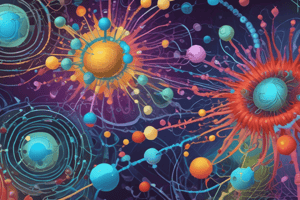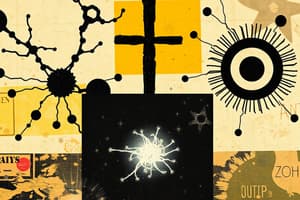Podcast
Questions and Answers
Which of these molecules are composed of 4 carbon rings?
Which of these molecules are composed of 4 carbon rings?
- Steroids (correct)
- Fatty acids
- Triglycerides
- Glycolipids
What type of molecule is the primary energy source for cells?
What type of molecule is the primary energy source for cells?
- ADP
- ATP (correct)
- RNA
- DNA
What type of fatty acid has one or more double bonds?
What type of fatty acid has one or more double bonds?
- Hydrophobic
- Saturated
- Unsaturated (correct)
- Trans fat
What is the primary function of DNA?
What is the primary function of DNA?
Why are phospholipids considered amphipathic?
Why are phospholipids considered amphipathic?
What is the role of tRNA in protein synthesis?
What is the role of tRNA in protein synthesis?
Which of the following molecules are NOT commonly considered a building block of fats?
Which of the following molecules are NOT commonly considered a building block of fats?
Which of the following is a nitrogenous base found in DNA but NOT in RNA?
Which of the following is a nitrogenous base found in DNA but NOT in RNA?
What is the name of the process that releases energy from ATP by cleaving a phosphate group?
What is the name of the process that releases energy from ATP by cleaving a phosphate group?
What is the role of eicosanoids in the body?
What is the role of eicosanoids in the body?
What role do enzymes play in chemical reactions?
What role do enzymes play in chemical reactions?
What is a cofactor in relation to enzyme activity?
What is a cofactor in relation to enzyme activity?
Which statement accurately describes exergonic and endergonic reactions?
Which statement accurately describes exergonic and endergonic reactions?
What distinguishes glycoproteins from proteoglycans?
What distinguishes glycoproteins from proteoglycans?
Which statement is true about lipids?
Which statement is true about lipids?
Flashcards
Enzymes
Enzymes
Proteins that speed up chemical reactions by lowering the activation energy.
Substrate
Substrate
The substance that an enzyme acts upon.
Coenzyme
Coenzyme
A non-protein organic cofactor that helps an enzyme function.
Exergonic Reaction
Exergonic Reaction
Signup and view all the flashcards
Endergonic Reaction
Endergonic Reaction
Signup and view all the flashcards
Fatty Acids
Fatty Acids
Signup and view all the flashcards
Saturated and Unsaturated Fatty Acids
Saturated and Unsaturated Fatty Acids
Signup and view all the flashcards
Eicosanoids
Eicosanoids
Signup and view all the flashcards
Triglycerides
Triglycerides
Signup and view all the flashcards
Steroids
Steroids
Signup and view all the flashcards
Phospholipids
Phospholipids
Signup and view all the flashcards
Nucleic Acids
Nucleic Acids
Signup and view all the flashcards
DNA (Deoxyribonucleic Acid)
DNA (Deoxyribonucleic Acid)
Signup and view all the flashcards
RNA (Ribonucleic Acid)
RNA (Ribonucleic Acid)
Signup and view all the flashcards
Nucleotides
Nucleotides
Signup and view all the flashcards
Study Notes
Chemical Level of Organization PT2
- Enzymes are catalysts, proteins that lower the activation energy of a chemical reaction.
- Enzymes are not changed or used up in the reaction, and they speed up reactions.
- An example of enzymes is frogs leaping over a rock wall, where activation energy is high, therefore fewer frogs get over (less product) .
Enzymes
- Substrates are reactants in enzymatic reactions.
- Active site: a location on an enzyme that fits a particular substrate.
- The enzyme-substrate complex is formed when the substrate fits into the active site.
- The enzyme converts the substrate to a product, and the unchanged enzyme is released.
Enzyme Helpers
- Cofactor: an ion or molecule that binds to an enzyme before substrates can bind.
- Coenzyme: nonprotein organic cofactors (vitamins).
Energy In, Energy Out
- Exergonic reactions produce more energy than they use; products have less energy than reactants; energy is released; spontaneous; entropy increases
- Endergonic reactions use more energy than they produce; products have more energy than reactants; energy is required; not spontaneous; entropy decreases
Protein Combinations
- Glycoproteins: large protein + small carbohydrate; includes enzymes, antibodies, hormones, and mucus production.
- Proteoglycans: large polysaccharides + polypeptides; promote viscosity; connective tissue components
Lipids
- Lipids: oils & fats (butter); fatty acids are organic acids with long carbon chains; mainly hydrophobic molecules such as fats, oils, and waxes; mostly made of carbon and hydrogen atoms
Classes of Lipids
- Fatty acids
- Eicosanoids
- Glycerides
- Steroids
- Phospholipids and glycolipids
Fatty Acids
- Building blocks of fats in our bodies and in the food we eat.
- Long chains of carbons bound to hydrogen.
- Saturated fatty acid (single covalent bonds only).
- Unsaturated fatty acid (one or more double covalent bonds).
Saturated and Unsaturated
- Saturated fatty acids are saturated with hydrogen (no double bonds), straight.
- Unsaturated fatty acids have one or more double bonds, causing a bend.
Different Kinds of Fat
- Unsaturated fats (good fats) can be found in nuts, avocados, vegetables; lower in calories compared to saturated fats.
- Saturated fats are mostly in animal products; recommended to reduce consumption for health.
- Trans fats are unsaturated but partially saturated with hydrogen; extend shelf life but negatively impact cholesterol.
Eicosanoids
- Fatty acids derived from arachidonic acid.
- Act as hormones.
Triglycerides
- 3-carbon glycerol linked to 3 fatty-acid tails.
- Fat storage molecule.
- High levels linked to cardiovascular problems.
Steroids
- Made of 4 carbon rings.
- Cholesterol: component of cell membranes.
- Sex hormones: estrogens and testosterone.
- Corticosteroids: metabolic regulation.
Phospholipids
- Amphipathic: hydrophilic head and hydrophobic tails.
- Create the cell membrane.
- Two fatty acid chains and phosphate.
Nucleic Acids
- Large organic molecules found in the nucleus.
- Store and process information at the molecular level (DNA and RNA)
- DNA (in the cell nucleus) contains the information needed to construct all proteins in the body.
DNA to RNA to Protein
- DNA in the cell nucleus contains the information needed to construct all the proteins in the body. This is transported through transcription and translation to produce RNA
RNA and DNA
- Nucleic acids form RNA and DNA from Long chains of nucleotides.
- RNA: single strand
- DNA: double helix joined by hydrogen bonds
Nucleotides
- Building blocks of DNA.
- Have 3 molecular components Sugar (deoxyribose) Phosphate group A, G, T, C: nitrogenous base
Nitrogenous Bases
- DNA: adenine (A) with thymine (T), cytosine (C) with guanine (G)
- RNA: adenine (A) with uracil (U), cytosine (C) with guanine (G)
Deoxyribonucleic Acid (DNA)
- Determines inherited characteristics.
- Directs protein synthesis.
- Controls enzyme production.
- Controls metabolism.
Ribonucleic Acid (RNA)
- Codes intermediate steps in protein synthesis.
Forms of RNA
- Messenger RNA (mRNA): corresponds to a gene and is processed to create proteins.
- Ribosomal RNA (rRNA): reads mRNA while holding it in place to bring the appropriate amino acids to add to the protein.
- Transfer RNA (tRNA): brings amino acids to attach to the growing peptide chain.
ADP and ATP
- Adenosine triphosphate (ATP): molecule with 3 phosphate groups; high-energy bonds.
- Adenosine diphosphate (ADP): molecule with 2 phosphate groups; lower energy.
- ATP releases energy when the 3rd phosphate group is broken off.
Dephosphorylation
- Cleaving a phosphate group from ATP to form ADP + Pi
- ATPase: enzyme that catalyzes the dephosphorylation.
- Release of energy occurs.
Phosphorylation
- Adding a phosphate group to ADP forms ATP
- A bond forms between 2nd and 3rd phosphate groups storing the energy.
- ATP synthase: catalyzes the phosphorylation.
ATP Dephosphorylation & Phosphorylation
- ADP and ATP are in equilibrium with each other, in order to provide or release energy for work.
Studying That Suits You
Use AI to generate personalized quizzes and flashcards to suit your learning preferences.




